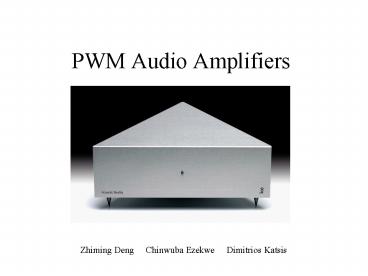PWM Audio Amplifiers - PowerPoint PPT Presentation
1 / 20
Title:
PWM Audio Amplifiers
Description:
Times New Roman Arial Default Design Bitmap Image Microsoft Equation 3.0 PWM Audio Amplifiers Outline PWM Basics Natural PWM (NPWM) Uniformly Sampled ... – PowerPoint PPT presentation
Number of Views:47
Avg rating:3.0/5.0
Title: PWM Audio Amplifiers
1
PWM Audio Amplifiers
Zhiming Deng Chinwuba Ezekwe Dimitrios
Katsis
2
Outline
- PWM Basics
- Digital Modulator Signal Flow
- Pulse Edge Delay Error Correction
- Volume Control
3
PWM Basics
- Efficient modulation method when only two states
(ON OFF) are available - Linear modulation Average pulse ON time
proportional to signal - Extract modulating signal with low pass filter
- Modulation depth (Mlt1) signal peak/triangle peak
www.powerdesigners.com
4
Natural PWM (NPWM)
- Straightforward analog implementation
- What about PCM input?
www.powerdesigners.com
5
Uniformly Sampled PWM (UPWM)
- Sample modulating signal at the edges of the
sawtooth - Use this to estimate the pulse width
- Problem Introduces an error!
Jorge Varona, http//www.eecg.toronto.edu/kphang/
ece1371/pwrdac.pdf
6
Weighted PWM (WPWM)
- Estimates pulse width using the information from
two consecutive samples
- NPWM approximation in the digital domain
- Yields improved THD compared to UPWM
Morten Kjaer Johansen et al, A review and
comparison of digital PWM methods for digital PMA
systems, Proceedings of the 107th AES
Convention, 1999.
7
Digital Modulator Signal Flow
- Oversampling gives better dynamic range
- WPWM is used to simulate NPWM in order to
decrease THD - Noise shaping also helps lower the bit-rate while
keeping a high resolution
Steen Munk et al, State of the Art Digital Pulse
Modulated Amplifier System, AES 23rd
International Conference, 2003.
8
Sigma-Delta Noise shaper
- Use noise shaping to preserve in-band SNR
9
Amplification Errors in Analog Power Stage
- Non-stable supply causes amplitude errors.
- Dead time in switches causes delay of rising edge
of output PWM signal. - Variation of load changes the frequency
characteristics of the demodulation filter. - Finite On resistance of semiconductor switch and
output filter resistance lead to output
resistance. - Non-linearity of the demodulation filter leads to
errors in the demodulated output signal.
10
Error Correction
- Analog signal referenced control system
- NOT POSSIBLE in a digital PMA because of the
absence of analog reference signal. - Pulse Edge Delay Error Correction (PEDEC)
- PEDEC is a pulse referenced control system
that eliminates all types of error by re-timing
the edges of the PWM inputs.
11
Pulse Edge Delay Error Correction
- Pulse referenced control system
- Eliminates error by retiming pulse edges
Karstem Nielsen, Digital Pulse Modulation
Amplifier (PMA) topologies based on PEDEC
Control, Proceedings of the 106th AES
Convention, 1999.
12
Edge Delay (ED) Unit
- Makes absolute correction
- No quantization error
- Limited correction range? saturates if correction
range is exceeded - Increasing phase lag of feedback signal w.r.t.
reference signal leads to saturation for very
short or long pulses
for
Steen Munk et al, State of the Art Digital Pulse
Modulated Amplifier System, AES 23rd
International Conference, 2003.
13
Voltage Feedback before Demodulation Filter
- Feedback from switching power stage output Vp.
- Feedback path compensator A(s) is a simple
attenuation. - No reference signal shaping
Karstem Nielsen, Digital Pulse Modulation
Amplifier (PMA) topologies based on PEDEC
Control, Proceedings of the 106th AES
Convention, 1999.
14
Voltage Feedback before Demodulation Filter
- 1st order reference shaping with matched 1st
order output feedback shaping
Karstem Nielsen, Digital Pulse Modulation
Amplifier (PMA) topologies based on PEDEC
Control, Proceedings of the 106th AES
Convention, 1999.
15
Voltage Feedback after Demodulation Filter
- Using global feedback from demodulator output Vo.
- 2nd order reference shaping
- This is the ONLY topology that eliminates the
errors in the demodulation filter
Karstem Nielsen, Digital Pulse Modulation
Amplifier (PMA) topologies based on PEDEC
Control, Proceedings of the 106th AES
Convention, 1999.
16
Volume Control
- A digital volume control is simple to implement
but will decrease the dynamic range as the signal
is attenuated. - An analog volume control can retain the dynamic
range, but it is not applicable to a digital PMA. - GOAL a volume control system that will not
decrease dynamic range. - Intelligent Volume Control (IVC)
17
Intelligent Volume Control (IVC)
- Use multiple supply voltages in power stage for
coarse control - Use digital attenuation through modulation depth
modification for fine adjustment
Steen Munk et al, State of the Art Digital Pulse
Modulated Amplifier System, AES 23rd
International Conference, 2003.
18
IVC (two-level example)
Steen Munk et al, State of the Art Digital Pulse
Modulated Amplifier System, AES 23rd
International Conference, 2003.
19
IVC Advantages
- Improved dynamic range
- Improved edge related noise
- Improved efficiency
- Improved electromagnetic interference (EMI)
characteristics
20
Summary
- Improve THD with WPWM
- Reduce noise by noise shaping
- Correct various errors through PEDEC
- Improve SNR of volume control by using multiple
supply voltages

